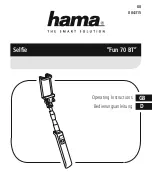
75.5911.02 20180226
Page 4 of 9
1.
With cabling in place, wiring at the terminal connector (image below, left) on the SuperScan-T Master module may be
completed. Wiring will vary according to the application. Available positions on the connector are shown below:
2.
Once all wiring has been completed, the endcaps and lens may be installed. At the SuperScan-T end of the cable (image below, A), leave
enough slack to allow a relaxed connection at the terminal block. Locate the SuperScan-T endcap that goes towards the hinge-end of the door.
Remove the tab at the bottom of the cap (image below, B) to allow insertion of the plastic sheath. Insert the plastic sheath (image below, C)
and install the endcap. The SuperScan-T lens may then be installed to fit tight against the endcap and plastic sheath to hold it in place (image
below, D). Leave the endcap off at the opposite end until all mechanical adjustments have been completed.
* Refer to the appendices of this document for various wiring schematics.
Terminal
Explanation of Wiring Connections
1
Test input
(when used as a monitored sensor)
(+) positive when utilizing monitoring
2
Ground
(-) negative when utilizing monitoring
Negative terminal if Input inhibition is used
3
Input inhibition
: All detection is ignored. Infrared emission is stopped.
Inhibition occurs when 12 – 24 VAC/VDC ±10% is applied between terminal 3 and terminal 2.
4
Normally Open
: JP2 factory default will close the relay contact on terminal 4 when the SuperScan-T
is energized and not in detection. Loss of power results in a N.O. contact
5
Normally Closed
: JP2 factory default will open the relay contact on terminal 5 when the SuperScan-
T is energized and not in detection. Loss of power will result in a N.C. contact.
6
Common
contact for relay
7
Power Input (-)
: 12 – 24 VAC/VDC ±10% must be supplied
8
Power Input (+)
: 12 – 24 VAC/VDC ±10% must be supplied
21
ELECTRICAL
INSTALLATION-
CABLING &
CONNECTIONS
A
B
C
D



























